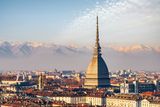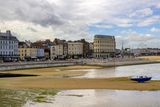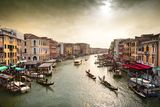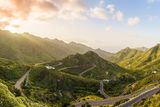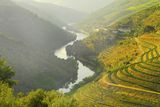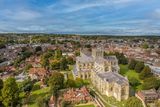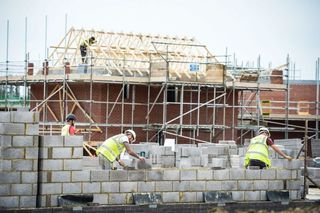Emilia Romagna has the perfect Bolognese
Emilia Romagna
Katy Harrington tucks into the home of Bolognese... a place where food is taken so seriously even the churches close for lunch.
Italy's Emilia Romagna region has pretty stiff competition from a rather famous neighbour so when visiting I'd advise you not to mention the 'T' word (Tuscany) if you want to stay in favour with the locals. There's no need for rivalry, really (oh, who am I kidding, this is Italy!), because Emilia Romagna has plenty to be proud of. Bologna, Modena, Ferrara, Ravenna and Parma are all here, so the region is not so much a poor relation but rather the cooler sibling of tourist-favourite Tuscany.
We start our trip in the region's capital - Bologna. Bologna has a few nicknames, Bologna the learned (Dante was born here, as was Umberto Eco, who was professor at the capital's university). It's also known as Bologna the fat (it's the home of Bolognese and food is taken so seriously here even the churches close for lunch), and Bologna the red (a reference to the red brick buildings and fact that Bologna became a communist stronghold in WWII).
We begin by walking the historical city centre and its majestic arcades (some of longest in the world), but it's even nicer to cycle, and there are free bikes to borrow on the streets and from most hotels. In one morning you can easily take in Palazzo d'Accursio o Comunale (the town hall) where the upper storey houses the museum Collezioni Comunali d'Arte, the iconic Two Towers (one of which is leaning, of course), and Piazza Maggiore, where you'll find the Basilica of San Petronius. To me, a church is just a church, but this one is home to the amazing St Petronio's Meridian. Created in 1656 by the teacher Cassini, it is the longest sundial in the world at 66.8 metres, admission is free and it is well worth stepping inside the church to see it.
There is always plenty of hustle and bustle by Neptune's fountain (and it's well worth paying attention to what the sirens are up to) but another of Bologna's quirky treats not to miss is a strange acoustic phenomenon at the Vault under the Palazzo del Podestà (known as The Meeting Place). Standing in opposite corners under the arches, you can whisper but still be heard perfectly by whoever is at the other side.
KNOCK-OUT: The Castello Estense in Ferrara, the mind-blowing home of the Este family
Finally, idle through the busy deli markets. The soil, water and temperature means this area has incredible local produce and it's a greedy treat to wander around trying chocolates filled with balsamic vinegar, local meats and cheeses or tortona. I'll leave it up to you whether you want to try the typical Torta con le Tagliatelle, a sweet tart made of dried pasta.
If the Bolognese passion for food inspires you then go to Il Salotto di Penelope for a cooking lesson and learn how to make an authentic spag bol (which is never eaten with spaghetti in Bologna). The best bit is that after slogging away making hand-rolled pasta and gnocchi (as soft angel's pillows) you get to sit down and eat it all.
The next day, we visited Modena, starting with a tour of the Luciano Pavarotti Theatre, where Pav sang and got married for his second time. If you are hanging out in Modena for lunch, Caffe Concerto in the Piazza grande has an incredible buffet of local delicacies. It's worth noting that anyone who has ever turned up his or her nose at Lambrusco will eat humble pie in Emilia Romagna, where the red sparkling wine comes from.
Modena is the birthplace of Enzo 'never four doors' Ferrari and the museum in his honour is a petrol head's dream. Not only can you drool at the Alfa Romeos, Maseratis and unmistakable sports class Ferraris, you can also have a poke around the man's family home and his father's workshop too.
Another other must-see in Modena is the Palazzo ducale Sassuolo, one of the best examples of northern Italy's baroque art. The castle's interior is as ostentatious and grandiose as you'd imagine but the courtyards and surrounding gardens are every bit as beautiful.
Finally, in the home of balsamic vinegar it would be rude not to see how the stuff is made. The Leonardi factory and warehouse is much prettier than it sounds, situated on the family's farm and provided the balsamic vinegar for Kate and Will's royal nuptials. Good grapes, good weather and time are what makes the vinegar here the best in the world, but it's the hundreds of wooden barrels that give it its individual taste, smell and colour. Every bottle is handmade and you can taste everything from the youngest three-year-old to 100 year old vinegar, costing about €200 for 50ml. For a fine dining finish to the day, local restaurant L'erba del Re is the best you'll find.
Day three takes us to Ferrara (nothing to do with Enzo Ferrari) but everything to do with the Este family and their mind-blowing home Castello Estense. Surrounded by a moat the castle is a knock-out outside and in with its red cotto brick, white balustrades, the picturesque Garden Of Oranges and the highlight - the prisons which eerily still have original graffiti on the walls. The best lunch (and that's saying something) was at Cusina e Butega where you might rub shoulders with local politicians drinking on the job.
Strolling, or pedalling around Ferrara (there are an average of 1.4 bikes to every person here) at the weekend is most entertaining. Visit the imposing cathedral, wander through the cobblestone streets and head to the Jewish ghetto, or get a coffee and sit and watch Italians drinking wine at 11am or shopping with dogs, bikes and shouts of 'Ciao bella' everywhere.
Last, we drove about an hour to the tiny town of Comacchio, a sleepy mini Venice where you can take a boat trip in the Po Delta, a Unesco World Heritage site. The marshes make an ideal climate for eels, insects, Flamingos (who go pink from eating shrimp by the way), cormorants, birds of prey and even the rare blue heron.
After a last supper in Bologna at the atmospheric Ristorante Ciacco we were in time to catch Millemiglia, a vintage car race which drives through the town. In true Bolognese style, once the drivers park up, everyone has a right old party. Tuscany should be worried.
GETTING THERE
Both Aer Lingus and Ryanair fly from Dublin direct to Bologna.
Accommodation at 4* Art Hotel Novecento, Bologna Art Hotels, www.bolognarthotels.it
Ferrari Museum: www.museocasaenzoferrari.it
For information on 1000 Miglia car race see: www.1000miglia.eu
For information see: www.emiliaromagnaturismo.com
Booking online at www.visitemiliaromagna.com
Join the Irish Independent WhatsApp channel
Stay up to date with all the latest news
